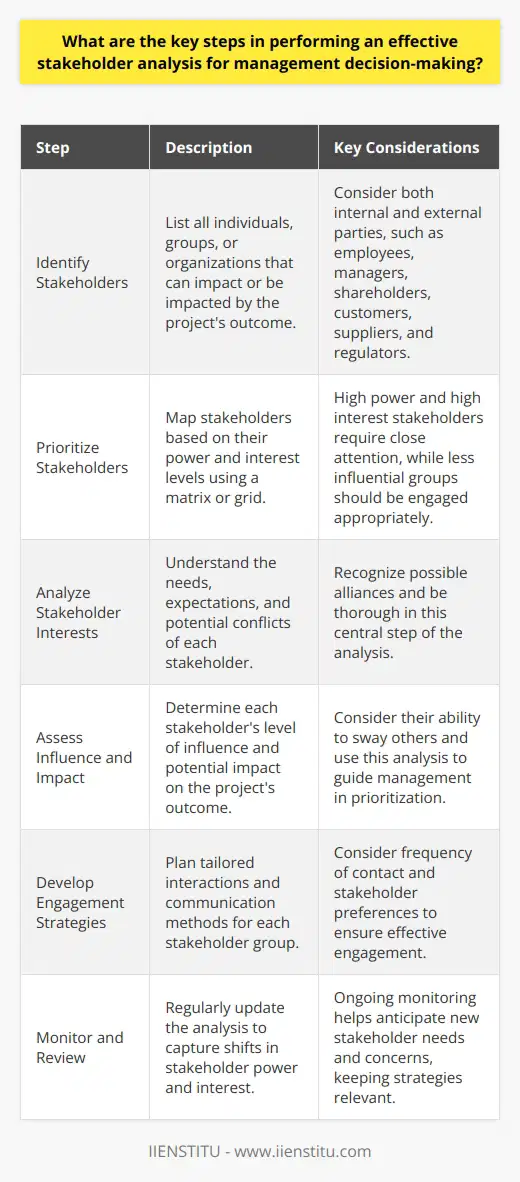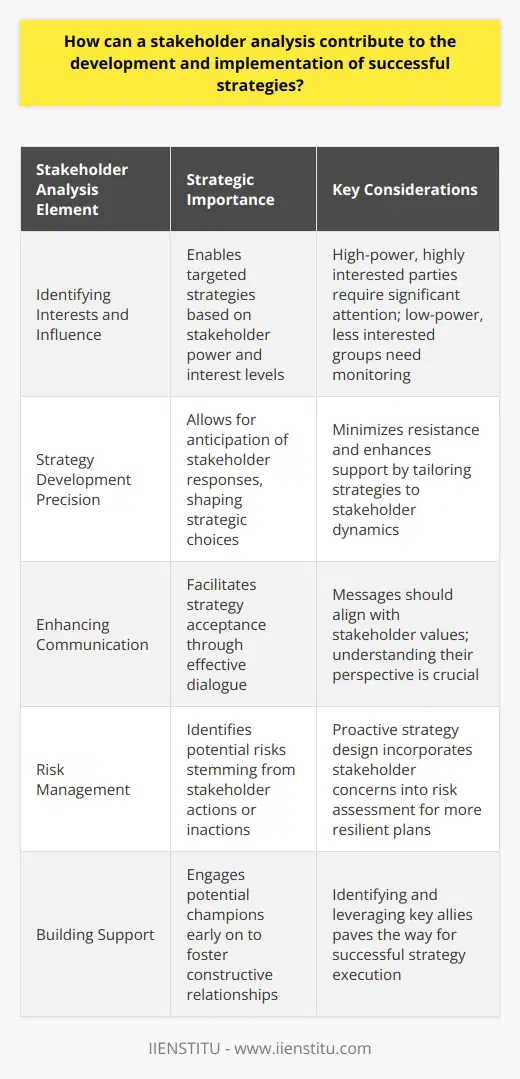
As a seasoned project manager, I've witnessed firsthand the transformative power of effective Stakeholder Analysis. It's not just a buzzword or a box to tick off on a project checklist; it's a fundamental tool that can make or break the success of any initiative. Throughout my career, I've seen projects soar to new heights when stakeholders are effectively managed and engaged, and I've also seen them crumble when their interests and influence are overlooked.
In this blog post, I'll be sharing my insights and experiences on navigating the complexities of Stakeholder Analysis. We'll dive deep into the fundamentals, explore the steps involved in conducting a successful analysis, discuss potential challenges, and examine real-world case studies that demonstrate its impact. By the end of this post, you'll have a solid understanding of how to apply these strategies to streamline decision-making and enhance stakeholder management in various business contexts.
The Fundamentals of Stakeholder Analysis

Identifying Stakeholders: The First Step
Who exactly is a stakeholder? This is a question that often sparks debate and confusion. In essence, a stakeholder is anyone who has a vested interest in the outcome of your project or business. They can be internal, such as employees, management, and board members, or external, like clients, suppliers, government bodies, and the local community.
Identifying stakeholders is the foundation of any successful analysis. It involves:
Brainstorming sessions: Gather your team and collectively identify all potential stakeholders.
Reviewing project documentation: Comb through project plans, contracts, and other relevant documents to uncover stakeholders.
Consulting organizational charts: Identify key players within your organization who may have a stake in the project.
Engaging with leadership and experienced team members: Tap into the knowledge of those who have been around the block and can provide valuable insights.
Analyzing Stakeholder Interest and Influence
Once you've identified your stakeholders, the next step is to understand their interests and influence. This is where the real magic happens.
Why do stakeholders care about your project? Their reasons can range from financial gain and job security to community well-being and regulatory compliance. Understanding these motivations is crucial for developing effective engagement strategies.
How much influence do they wield? Some stakeholders, like shareholders, may have significant financial clout, while others, like government bodies, may have regulatory power. Assessing the level of influence each stakeholder possesses helps prioritize your engagement efforts.
Tools like stakeholder mapping matrices and influence-interest grids are invaluable for visualizing where stakeholders stand. These tools allow you to categorize stakeholders based on their level of interest and influence, making it easier to tailor your communication and management strategies.
Conducting a Successful Stakeholder Analysis
Now that we've covered the fundamentals, let's dive into the nitty-gritty of conducting a successful Stakeholder Analysis.
Step 1: Identify Stakeholders

As mentioned earlier, the first step is to identify all potential stakeholders. This can be done through various methods, such as:
Stakeholder interviews
Surveys
Analysis of business processes and market environments
Step 2: Assess Stakeholders' Interests

Once you've identified your stakeholders, it's time to understand their specific interests in relation to your project or business. This involves examining their:
Needs
Concerns
Expectations
Potential impact of the project on them
This step allows for a nuanced understanding of each stakeholder's perspective.
Step 3: Determine Stakeholders' Influence and Importance

High-influence stakeholders can make or break your project, so it's crucial to determine the degree of each stakeholder's power. This step assesses who among the stakeholders holds sway and can affect project outcomes, for better or worse.
Step 4: Develop Stakeholder Engagement Strategies

Armed with an understanding of stakeholders' interests and influence, you can now craft tailored engagement strategies. These might include:
Communication plans
Consultation initiatives
Negotiations
Partnership developments
The goal is to involve stakeholders constructively and align their interests with the objectives of your project or business.
It's important to note that this process is iterative and should reflect the evolving nature of stakeholders' interests and influence over time. Real-life application of these steps often uncovers insights that guide the strategic direction of projects and businesses.
Potential Challenges and How to Overcome Them

While Stakeholder Analysis is a powerful tool, it's not without its challenges. Some common hurdles include:
Ambiguity in stakeholder identification: It can be difficult to determine who exactly constitutes a stakeholder, leading to either an overly inclusive or restrictive approach.
Varied stakeholder interests: Divergent stakeholder interests can complicate analysis and require careful navigation to find a balance.
Difficulties in engaging stakeholders: Engaging stakeholders with diverse backgrounds and expectations can be a significant challenge, requiring tactful communication and a willingness to seek common ground.
To overcome these challenges, consider the following strategies:
Develop robust communication plans
Engage in ongoing dialogues with stakeholders
Employ dynamic assessment methods
Adopt an adaptable approach to address evolving stakeholder positions
Real-World Applications: Case Studies
To truly appreciate the value of Stakeholder Analysis, let's look at some real-world examples:
Multinational Corporation: A global company used Stakeholder Analysis to navigate the complexities of international markets and regulatory environments, successfully expanding into new territories.
Small Business: A local business owner employed Stakeholder Analysis to align community interests with expansion plans, resulting in increased support and customer loyalty.
Non-Profit Organization: A non-profit used Stakeholder Analysis to identify and engage key donors and partners, leading to increased funding and successful program implementation.
These case studies demonstrate the versatility and impact of Stakeholder Analysis across various industries and project scales.
Conclusion
In today's complex business landscape, effective stakeholder management is no longer a nice-to-have; it's a must-have. By conducting thorough Stakeholder Analysis, you can navigate the intricacies of stakeholder relationships, make informed decisions, and ultimately, drive your projects and business towards success.
Remember, Stakeholder Analysis is not a one-and-done exercise. It's an ongoing process that requires continuous refinement and adaptation. As your projects evolve and stakeholder dynamics shift, so too must your engagement strategies.
So, whether you're a seasoned project manager or just starting out, I encourage you to embrace the power of Stakeholder Analysis. It may seem daunting at first, but trust me, the rewards are well worth the effort. By understanding and aligning stakeholder interests, you'll be well on your way to achieving your project and business goals.
Happy analyzing!
Frequently Asked Questions
What are the key steps in performing an effective stakeholder analysis for management decision-making?
Understand Stakeholder Analysis
Stakeholder analysis is a vital tool. It aids in identifying key players. These players can influence or hold influence over a project's outcome. This process helps inform management strategies. Stakeholder analysis is not simple. It demands careful planning and execution. Following specific steps ensures effectiveness. It facilitates making informed decisions.
Identify Stakeholders
Begin with listing stakeholders. Anyone with project impact or interest counts. Consider internal and external parties. Employees, managers, and shareholders are typical examples. So are customers, suppliers, and regulators. Think broad. Miss no potential influencers.
Prioritize Stakeholders
Not all stakeholders are equal. Their power and interest levels vary. Map stakeholders based on these attributes. Use a simple matrix or grid. High power and high interest stakeholders need close attention. They are key to successful management decision-making. Less influential groups should not be ignored. Engage them appropriately.
Analyze Stakeholder Interests
What do stakeholders want? Understand their needs and expectations. Each stakeholder has unique interests. Recognize potential conflicts. Anticipate possible alliances. Be thorough here. This step is central to effective analysis.
Assess Influence and Impact
Determine each stakeholder's level of influence. How might they affect the outcome? Consider their ability to sway others. Assess the impact. What does this mean for the project? Influence and impact analysis guides management in prioritization.
Develop Engagement Strategies
Plan interactions with stakeholders. Tailor communication. Each group may require different approaches. Develop a strategy for effective engagement. Consider frequency of contact. Factor in methods of communication. Make it fit the stakeholders' preferences.
Document and Communicate
Record your findings. Create detailed stakeholder profiles. Share this information with relevant team members. Transparency ensures everyone understands stakeholder dynamics. This aids in unified decision-making.
Monitor and Review
Stakeholder positions can change. Monitor shifts in power and interest. Update your analysis regularly. This keeps strategies relevant. It also anticipates new stakeholder needs and concerns.
Stakeholder analysis is not a one-time activity. It demands ongoing attention. It helps management to make well-informed decisions. This process aligns project objectives with stakeholder expectations. It lays a foundation for successful project execution.

How can a stakeholder analysis contribute to the development and implementation of successful strategies?
Understanding Stakeholder Analysis
Stakeholder analysis plays a pivotal role in strategic management. It maps out key parties' interests. This process involves identifying individuals, groups, or organizations. They can affect or receive effects from a project. Stakeholder analysis aids in comprehending these dynamics. It results in more informed, effective strategies.
Identifying Interests and Influence
One must first pinpoint stakeholders. After identification, understand their power and interest levels. High-power, highly interested parties demand significant attention. Low-power, less interested groups require monitoring. Strategies can evolve from this nuanced understanding.
Strategy Development Precision
Strategies become targeted with stakeholder analysis. It provides a lens through which to anticipate responses. Anticipated reactions shape strategic choices—minimizing resistance, enhancing support.
Enhancing Communication
Effective strategies depend on communication. Tailored messages resonate with different stakeholder groups. Understand their values; align communication accordingly. Effective dialogue facilitates strategy acceptance.
Risk Management
Risks stem from stakeholder actions or inactions. Awareness allows for proactive strategy design. Stakeholders' concerns become part of the strategic risk assessment. The result: more robust, resilient plans.
Allocating Resources Wisely
Resources are limited. Stakeholder analysis guides their allocation. Direct resources to actions that influence key stakeholders. Maximize impact; optimize outcomes.
Building Support
Support is critical for strategy execution. Stakeholder analysis identifies potential champions. Engaging these allies early on fosters constructive relationships. Their support paves the way for strategy success.
Monitoring and Feedback Integration
Stakeholder analysis is not a one-off activity. Continuous monitoring captures shifts in the stakeholder landscape. Feedback loops allow for dynamic strategy adaptation. Stay responsive; adjust strategies as stakeholder attitudes evolve.
The Lasting Impact of Stakeholder Analysis
Strategies crafted with stakeholder analysis foresee challenges. They leverage stakeholder strengths. When done well, analysis transcends individual projects. It builds a foundation for lasting organizational strategy. This approach underpins successful strategic implementation. Stakeholder analysis turns potential obstacles into pathways for success.

What are some common challenges in stakeholder analysis and how can these be addressed effectively?
Identifying All Stakeholders
Stakeholder analysis begins with identification. You must find all relevant parties. To address this, create comprehensive lists. Use previous project data, organizational records, and team brainstorming. Cross-reference sources to ensure completeness. This makes the identification process robust.
Addressing Diverse Interests
Stakeholders have different priorities. Understanding these interests often proves challenging. Access better outcomes by conducting interviews. Surveys also help. Combine qualitative and quantitative methods. Analyze data effectively. Seek common ground among stakeholders. This ensures you cater to a broad spectrum of interests.
Analyzing Stakeholder Influence and Power
Determining influence levels is essential. Some stakeholders wield more power than others. Use power-interest grids to map influence. This visual tool aids in prioritizing engagement strategies. Regular updates to this map are critical. Influences evolve. Your analysis must evolve as well.
Overcoming Communication Barriers
Effective communication is key. Barriers often impede this. To overcome this, employ various communication channels. Ensure messages are clear and concise. Tailor communication to fit stakeholder preferences. Listen actively to feedback. Adapt your approach as necessary. This will promote better understanding and collaboration.
Securing Stakeholder Engagement
Stakeholder engagement poses significant challenges. Interest may wane over time. Maintain engagement by providing regular updates. Incorporate their feedback into project plans. Host interactive sessions. These can include workshops or Q&A forums. Recognize their contributions. Celebrate milestone achievements together. This fosters a sense of ownership and continued interest.
Addressing Conflicts of Interest
Conflicts among stakeholders are common. Transparent processes mitigate such conflicts. Establish clear objectives from the start. Develop a conflict resolution plan. Act on conflicts swiftly. Encourage open dialogue among stakeholders. Facilitate mediation if necessary. This approach helps in maintaining a focus on common goals.
Managing Stakeholder Expectations
Stakeholders have expectations. They can be unrealistic at times. Address this through regular reality checks. Provide clear project updates. Present feasible scenarios, not over-optimistic forecasts. Adjust expectations through education. Explain limitations and constraints. This alignment ensures stakeholders have realistic project views.
Ensuring Continuous Stakeholder Analysis
Stakeholder analysis is not a one-off task. It demands continuous attention. Reassess stakeholder maps periodically. Account for shifting power dynamics. Address newly emerged stakeholders. Adapt engagement strategies in response. This commitment to ongoing analysis ensures your approach remains relevant and effective.
In conclusion, stakeholder analysis encounters multiple challenges. Tackle these effectively through methodical practices. Employ diverse data collection methods. Use tools to map stakeholder power. Communicate with clarity and purpose. Engage stakeholders actively. Manage conflicts and expectations with transparency. Commit to continuous analysis. These strategies support effective stakeholder analysis, pivotal for project success.



